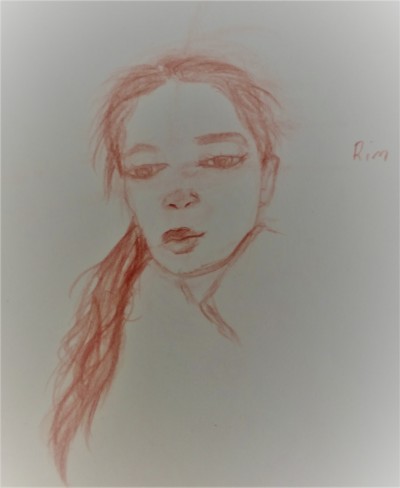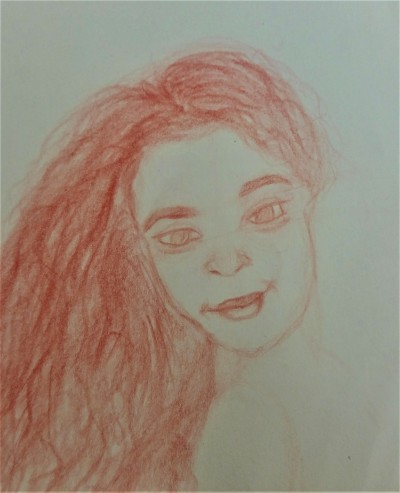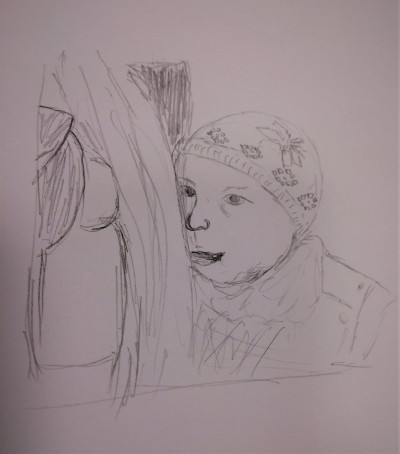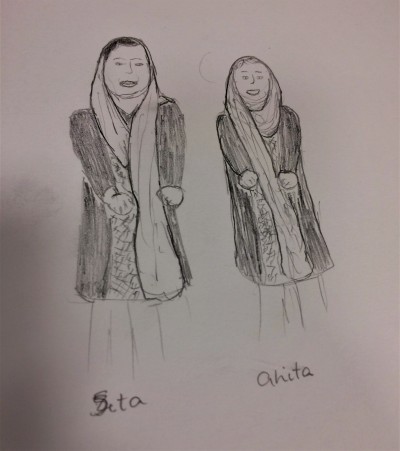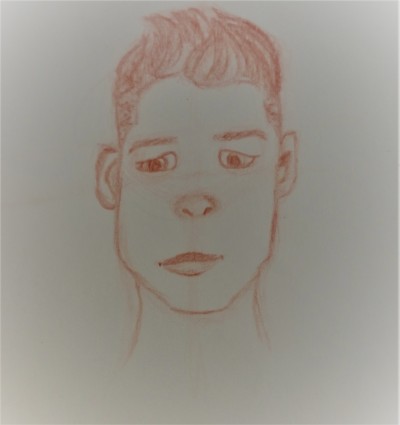“All we have is our stories” – Nadina Christopoulo (Melissa Network)
More than anything, this experience gave these children faces and character. They were no longer just a group of refugee children but children with names, faces and personalities. Even though we may not know their entire life stories, we know them as individuals. In some ways I think this may be even better, as it allowed us to see them beyond their past, to view them not with pity but with love. As such, we have decided to do profiles about some of the children we met to immortalise our interactions with them.
Sketched by Tyeece Hensley & Gabrielle Branche as pictures were not allowed.
Rim – The Ringleader
The little girl with a big voice. She is from Syria with startling blue eyes. She enjoys dancing and is very assertive. When the lights turn off she is the first to scream and when Despacito turns on she is the first to start dancing. She adores the attention and never hesitated to join us in the front of the room when we were showing them choreography. The other children respect her and follow her lead, particularly Lauren who took Rim’s, dauntlessness as the okay to take initiative as well. She often translated for some of the other children as her English was very proficient. She was very friendly but at the same time very stubborn. At the market she was to first to fold her arms as the children from the other camps danced. Likewise the rest of our children followed. Yet she is still an open impressionable style. When an Arabic song was played that she did not like, she protested loudly but as Hetvi started showing them the dance she eagerly participated. She was definitely a strong character, very memorable and much appreciated
Mina – The Dancer
Mina was one of the twins (Mina and Lina) being the more outspoken one, we interacted with her first. She had a sweet smile and a warm hug, she was friendly and well behaved. She enjoyed learning our dances and caught on quickly. When the children showed us their dances, she always knew them the best and her execution and glow as she danced stood out to me. I really hopes she continues dancing because she is good at it and generated pure enjoyment as she dances. She is also very protective of her dancing. At the market she was one of the hardest to convince to cheer on the other group, far less dance with them. Her sister Lina followed her and the both sat very critical or stood arms folded sizing up the other group. She was also the one to gather the others and encourage them to practice the dances we taught them when she saw the other group practicing. She is fierce and determined yet sweet and receptive. She was definitely one of my favourite children in the camp.
Hanie – The Old Soul
Hanie was the first girl we interacted with. She was open and mature beyond her years. She is from Pakistan and naturally connected with Nandini Hetvi and Lubnah due to the common language. She was well mannered and took well to instruction but still gave her opinion and even acted as a mouthpiece for other children. She was one of the older students but was still very enthusiastic about the dances. Out of all the children at the camp she was perhaps the one we learnt most about as she opened up to Nandini about her family.
Amid the wild and chaotic energy of the Eleonas children, there was a little girl who was quiet, mindful, and radiated with positivity. As the others jumped and screamed and played, Hanie would sit in a corner practicing the Kathak steps we had taught her, repeating each step multiple times and relentlessly attempting to improve her precision and grace. I wasn’t sure if it was because she felt excluded or was just passionate about dance – perhaps both. She once told me, “I have no friends at the camp. But I’m the first to befriend volunteers and instructors like you.” She went on to share that she was living in the camp with her father, waiting to reunite with her mother who was working in Switzerland. Later, Sophie revealed that Hanie was one kid she worried about constantly; she would occasionally see bruise marks on Hanie’ body and sometimes would find her father either shouting or locking her indoors, refusing to allow her to play outside. Sophie went on to say that they had no concrete proof, but this deeply affected me…seeing a girl with so much light and potential inside her possibly being mistreated behind closed doors was heartbreaking.
Hacin – The Whirlwind
Wow! This little cutie was an absolute whirlwind. Not more than 5 years old, he was filled with energy and could not stay still. He took a liking to Rodrigo and Akash climbing on them and playing with them throughout the sessions. He also enjoyed turning on and off the lights making the other children start screaming. He then proceeded to make a game out of it when Debra tried to block the switch. He did join in some of the dancing but was simply too young to stay attentive for more than five to ten minutes at a time. Still his presence was endearing and we believed that he enjoyed being there. When i asked him his name he kept repeating it until I got it right and then decided that play fighting with Rodrigo was more interesting. I would love to see how he ages and where he channels his energy. His pure innocence and active approach to the world contrasts with the helplessness of the situation but I really hope he grows up to a better life.
Maxa – The other
Maxa was the ringleader of the Afghani girls dancing with us. There were only three afghani girls and at first they felt quite left out as they did not like the choice of songs that we made. They did learn and enjoy the dances but the really wanted to show us their own dance to certain afghani songs. Maxa was the one communicating this to us and speaking on behalf of the three girls. They were persistent yet respectful. Even though we took a while to play their songs because we were unable to download them, they came day after day learning the dances we showed them, and asking again for their music. Maxa was quite outspoken and quite endearing. She always gave us hugs and remained positive even when they were frustrated and felt excluded. She showed me that even though these may all be children and although they may share similar experiences, there are still cultural barriers that are difficult to overcome (except of course through Despacito which all the children loved :p ) when we did play their songs Maxa and crew were extremely happy and danced with no reserve despite being the only ones knowing the song. They were also extremely playful with one of the caregivers who seemed to also afghani and equally teasing them. One intriguing thing about Maxa and her friends was the fact that they took warmly to Ana, talking to her a lot at the market and hugging her and laughing with her. Having spoken to Ana about the fact that generally children are usually very precocious around her, it was interesting to view their interaction with her. Maxa truly left an impression on me.
Sita and Gita – the Bollywood Sisters
Bubbly, vivacious, and utterly endearing, these two Afghani sisters stole our hearts at the Melissa Network. I was struck by their first impression itself – two Muslim girls with traditional Hindu names. On asking them about the story behind their names, the girls exchanged a sneaky glance and giggled coquettishly. Later, they explained how their mother loved a Bollywood film with two characters Sita-Gita so much, that she decided to name her daughters after them. This got us all laughing as we realized the widespread of Bollywood films, and more so, the beautiful entwinement of cultures and religions. As we started a spontaneous dance workshop with the girls, we were once again taken aback by the impressive skill and passion the two sisters had for dance. Each had a different dance style – while Gita had fantastic hip-hop moves, Sita danced unabashedly to Bollywood music. But no matter what the other did, or how different they were from one another, they supported and cheered each other on till the very end. We went on to call them the Bollywood Sisters, and named the whole dance group, Bollywood Bombshells.
Alishba – The Survivor
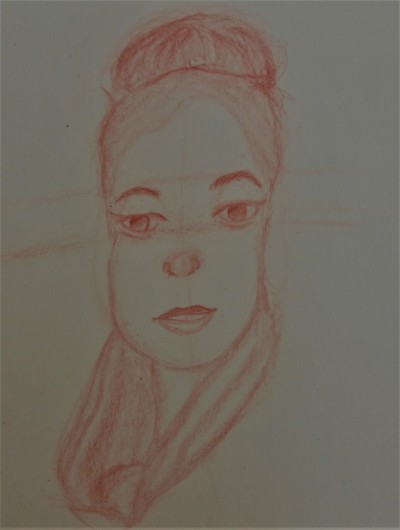
She sat quietly at the edge of table as we had lunch at the Melissa Network, shyly smiling at me yet avoiding eye contact. I approached her and we began conversing in Urdu. It took time, but soon she opened up and began sharing her journey as a refugee. As a Shi’a Muslim in Pakistan, her family faced insurmountable challenges – her grandfather was shot thrice in the head, her uncle’s arms were cut off…her family had no choice but to leave. Her escape from Pakistan to Greece entailed 20 hours of unending trekking, finding dead bodies on the path of those who couldn’t make the journey, days in a confined ship container in Iran, isolated in a box-like room with 10 members of her family for weeks in Turkey…and then finally she made it to Greece – her first entry point into Europe. “There were moments when I didn’t think I would make it,” she shared. But she did. Alishba has now received asylum in Greece, she is enrolled at a local university and comes once a week to the Melissa Network for Greek classes.
Hassan – The Runaway
Of the 22 refugees being celebrated at the Greek National Museum of Contemporary Art, Hassan was the first to share his story. After his presentation, a group of us went up to speak to him. With Urdu as a common language, Hassan felt comfortable enough to open up to us about his real journey – one not as a refugee, but rather a runaway. On asking him why he left Pakistan – a country not specifically wrenched in war or bloodshed – he shared that it wasn’t about war, he “just couldn’t stay there anymore.” Hassan came from a family that didn’t value him or give him freedom – he wasn’t allowed to complete his education. Consumed by a deep sense of confinement and neglect, he decided to escape his country as a refugee as he believed that it was the only way he would be able to flee and gain asylum. His story triggered off a heated yet thought-provoking debate among our group – was Hassan ethically right? Did he have a choice? Was we taking the place of a real refugee under threat? But most importantly, were we in a place to judge him? I haven’t quite found a definite answer to these questions, nor has our debate been resolved, but our encounter with Hassan has definitely shed light on the grey areas existing in the phenomenon of refugeehood and made us realize that sometimes it’s not about what’s right or wrong, but rather what’s at stake– if we were in his shoes would we have maybe done the same?
